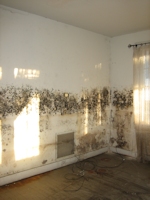
A few years back, I made an appointment to show a property.
In the listing, the property obviously required work, and it was mentioned in the Realtor Remarks that it was a “handy-man fixer-upper”. The listing had not prepared me, even slightly, for what I was in for.
The electricity was not turned on. Luckily I had my handy-dandy flashlight with me. The house was vacant, and filthy. Not just a little filthy, but disgusting, gross, I-need-a-hazmat-suit-and-a-shower filthy. There was, what appeared to be, black mold everywhere. Windows were cracked or broken. The toilet had been removed and the hole had not been covered or plugged. The stench and filth was unbelievable. This was my first showing of the day with the client.as in for.
I have some allergies. I know that I am sensitive to mold, and will get a headache and have difficulty breathing upon exposure. Of course, this is not scientific, so I can’t disclose this to a client. I spent the next 3 hours driving the client around feeling incredibly ill and not able to even mention it. I was furious.
Where does our responsibility to our Seller come into conflict with letting other Realtors and Consumers know about possible hazardous conditions. This property should have been condemned (I actually think it was eventually), but at the least, I should have had fair warning as to it’s condition.
The Real Estate Industry needs some standards when it comes to listing information, and every Real Estate Professional needs to make sure they are letting their fellow colleagues know when dangerous or hazardous conditions exist in their listed properties.